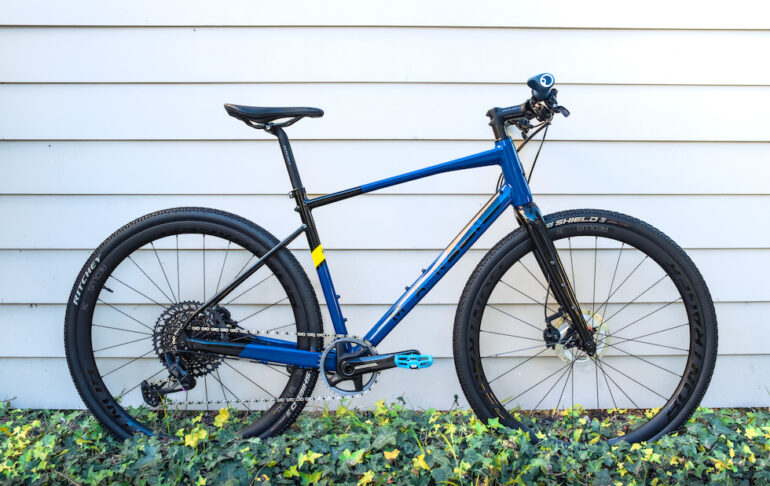I’m sharing a flat bar all-road bike project I’ve been working on. You might be wondering, why would I do that? Well, let me explain.
All-road bikes are versatile, comfortable, and fun to ride on different terrains. They can handle anything from smooth pavement to flat, hard-pack trails and have plenty of mounts for accessories like bags, racks, and fenders. They are also great for bikepacking, touring, and commuting.
But there’s one thing that I don’t like about most all-road bikes: the drop bars.
Don’t get me wrong, drop bars have their advantages:
- Multiple hand positions
- Better aerodynamics
- More leverage for braking and shifting
But they also have some drawbacks:
- Uncomfortable for some riders on trails or rough surfaces
- Limit visibility and control, especially in traffic or tight corners
That’s why I decided to build a flat bar all-road bike. I don’t have excess bike storage, so I want bikes that combine the best of both worlds: gravel bike’s versatility and flat-bar bike’s simplicity and stability.
I want bikes I can use for various rides, whether a casual fitness ride around town, a challenging gravel adventure, or a distance road ride down the coastline here in Southern California.
Building a Flat Bar All-Road Bike
So, what exactly did I build? Here’s where things get interesting.
I started with an all-road bike frame I had in storage. The first rule in cycling is you can never have enough bikes. When you find a frame on sale for an unbeatable price—buy it and store it for later.
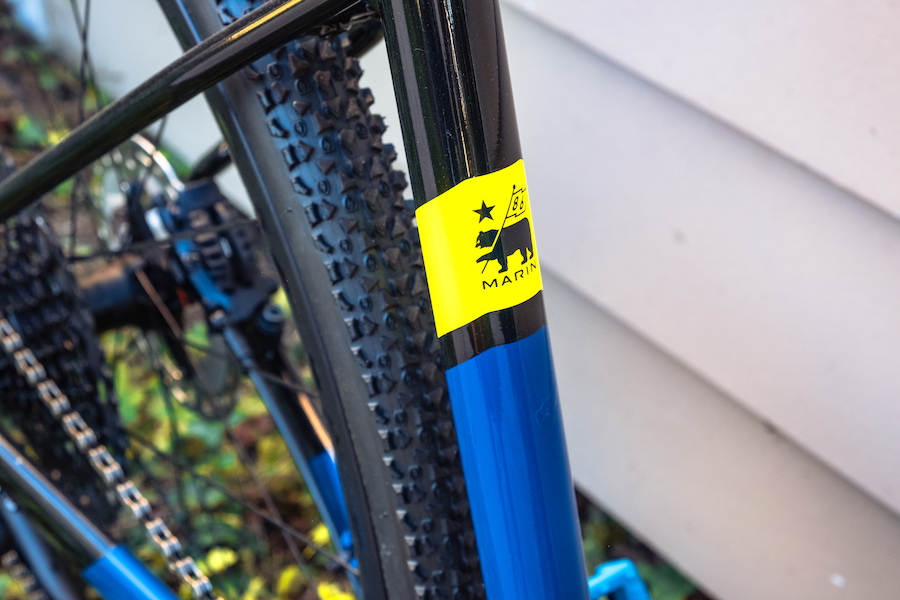
What is the Marin Fairfax flat-bar road frame? It’s a series 3 6061 aluminum frame with highly formed, butted custom tubes and machined and relieved head tube and BB shell. Details include:
- Relieved tapered head tube and BB
- Internal cable routing
- Flat-mount disc-specific forged dropouts
- Fender mounts
- Front and read rack mounts
- Marin full carbon fork w/ taper steerer
- 12mm thru-axle front and rear
Next, I chose a mechanical SRAM GX Eagle drivetrain. Details include:
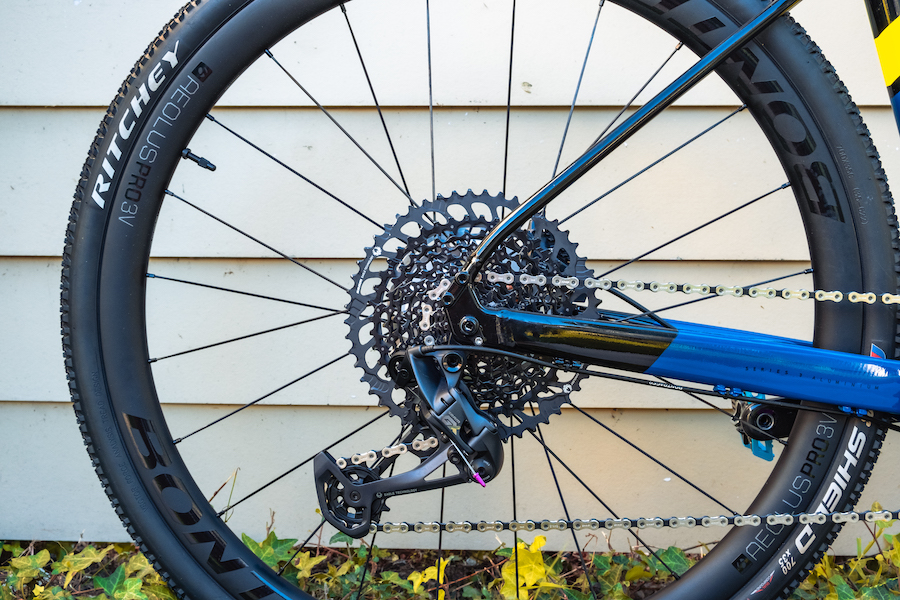
- Sram Force 1×12 crankset 40t
- Sram GX Eagle derailleur
- Sram GX Eagle cassette XG-1275 10-52
- Sram GX Eagle trigger shifter
- Sram GX Eagle 12spd chain
Do I recommend a mix-and-match SRAM mountain drivetrain for all-road riding?
The short answer is yes, 100%.
In this case, a mixed drivetrain pairs a road or gravel crankset with a wide-range mountain bike rear derailleur, a 1×12 GX Eagle.
A mixed drivetrain works like a regular road, gravel, or mountain bike drivetrain, but only if the cable pull ratios of road shifters and mountain bike derailleurs are the same. Therefore, an MTB group works flawlessly with the SRAM Force crank.
The Force 1x crank is my splurge for this everyday bike; it’s light, stiff, and pretty. The chain line measurements work well with GX Eagle, too.
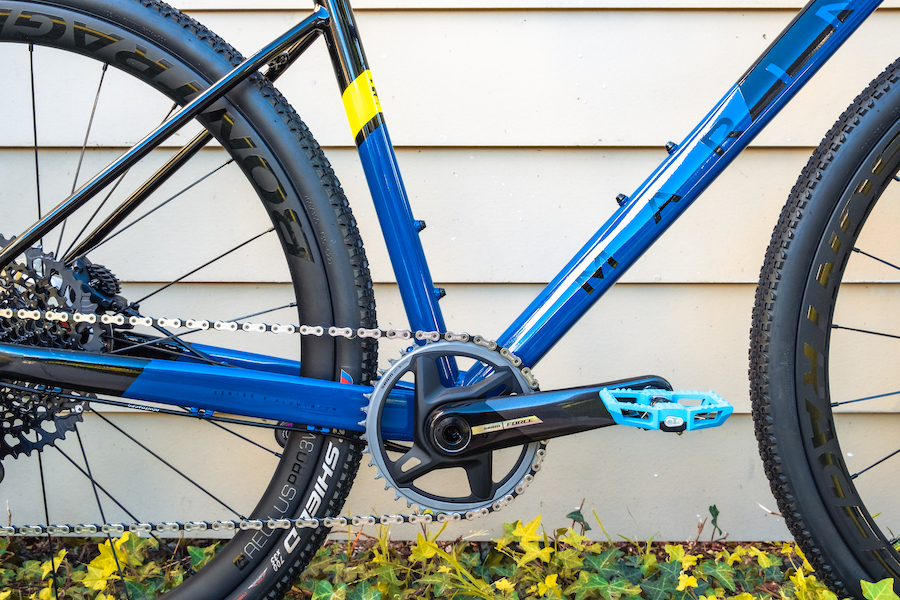
Why choose SRAM GX Eagle for your flat bar all-road bike? Shops and riders everywhere trust the Eagle groups for durability, simplicity, and shifting perfection in all conditions.
Few riders can say anything negative about the group, especially the GX Eagle rear derailleur, which is light enough and can take a beating without failure. This group will outlast everything on your bike, so I want it on mine.
Bontrager Aeolus Pro 3V TLR Disc Road Wheels
We pleaded our case for the Bontrager Aeolus Pro 3V TLR Disc Road Wheels, which they kindly provided for this flat-bar gravel bike project. Is a $1400 MSRP carbon wheelset necessary for an all-rounder bike like this? Of course not. But the heart wants what it wants.
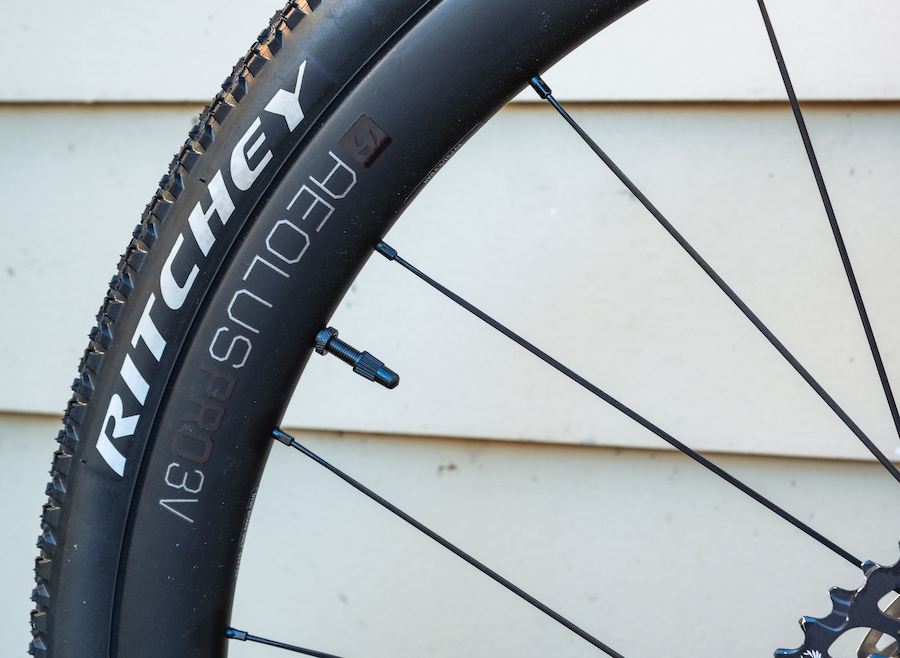
In this case, I couldn’t live without a sturdy, deep carbon wheel designed specifically for gravel tires and on-dirt use—with a 38mm external!
Three months into ownership, I have zero complaints about the stiffness-to-weight ratio. For the price, you can find lighter wheels; however, this carbon layup results in a consistent feel across the pavement and hard dirt—a must for this do-it-all bike.
Aeolus Pro 3V has a wide 25mm internal rim to run lower pressure for better tire support, added traction, better cornering, and a faster, more comfortable ride. Rapid Drive 108 road hubs add snappy engagement for an all-around better ride.
Snappy is the selling point for this wheel. I compared the Rapid Drive 108 hub to a few others, including Zipp’s 76/176 on their 303s wheels—the Bontrager option is impressive and super quick to engage, which is essential for a bike I want to perform on the road.
At 35mm deep, the Aeolus Pro 3V isn’t deep enough to cause drag in most conditions. And most importantly, their looks could kill. They look and feel solid beneath you. If you can spend the money, I can’t think of a more appropriate wheelset for an all-rounder flat-bar gravel bike.
Flat-Bar Road Ritchey Logic Cockpit
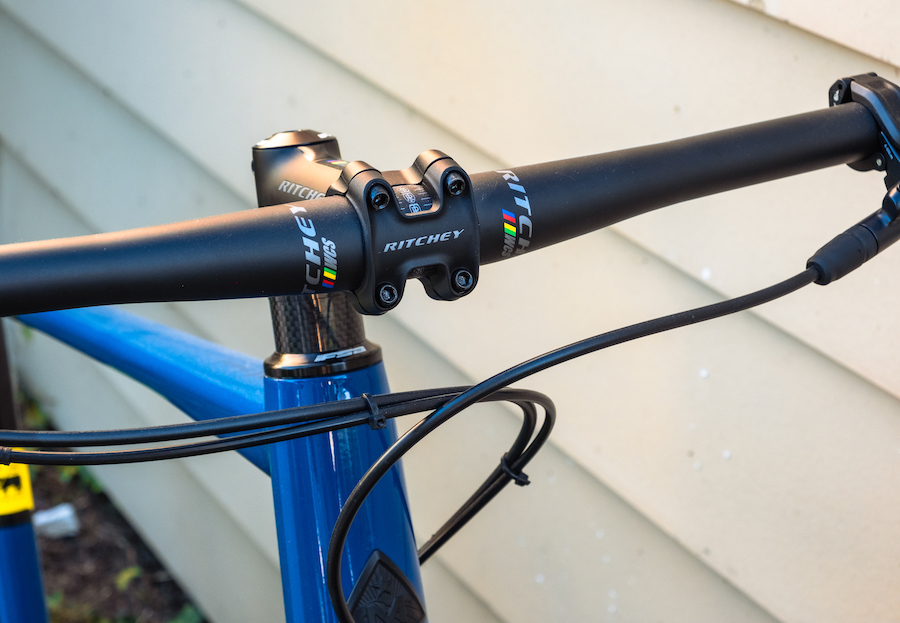
This flat-bar gravel bike project features Ritchey components from front to back. I’ve built five bikes with Ritchey cockpit parts over the past five years—not one experienced a failure or fit issue. And to trust a brand with a rich history in manufacturing components across all riding disciplines—well, that’s logic. Details include:
- Ritchey WCS C220 stem
- Ritchey WCS 1-bolt seat post
- Ritchey WCS flat bar (cut to 720mm)
- Ritchey Shield tire (700x35mm)
Have you experienced a 1-bolt seat post? Multiple shop employees applauded the design and ease of use during this project— because nobody has time to screw around with their seat posts.
More Notable All-Road Bike Parts
Shimano’s mountain bike brakes are tough to beat, especially when you want real stopping power in a light yet durable package. The Shimano SLX brakes with XT center-lock rotors are a formable combo for flat-bar bikes; they’re tried and true among thousands of riders worldwide. I love how confident I feel knowing anything short of a technical trail is fair game with this setup.
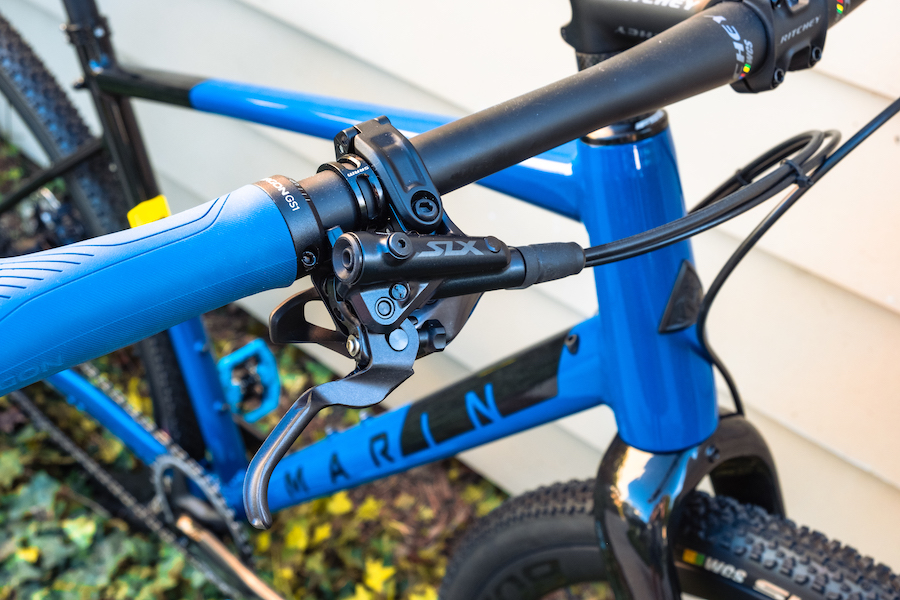
Finally, this would be an all-rounder flat-bar gravel bike without an added touch of comfort under the palms and tush. I went with Ergon’s GS1 Evo grips because I enjoy the larger wing design; it reduces hand fatigue and intermittent numbing in the fingers. And the midnight blue is dope—they match the frame perfectly.
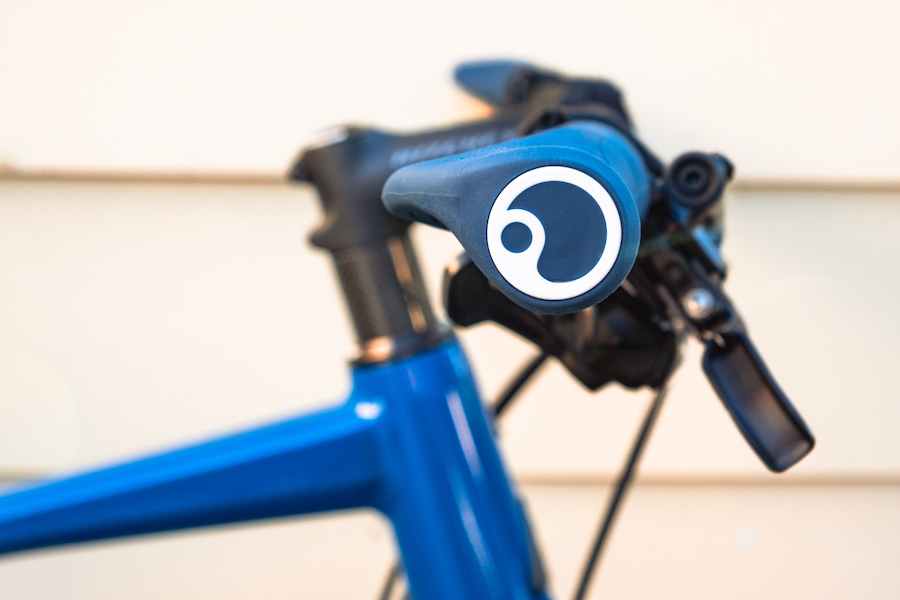
I also went all-in on comfort with Ergon’s SR Allroad Core Pro saddle. According to Ergon, this all-road design offers an entirely new riding experience: road shock and vibrations are fully damped, numbness in the perineal area is alleviated, and seat pressure is significantly reduced – allowing you to be fully in sync with your bike, whatever your chosen path.
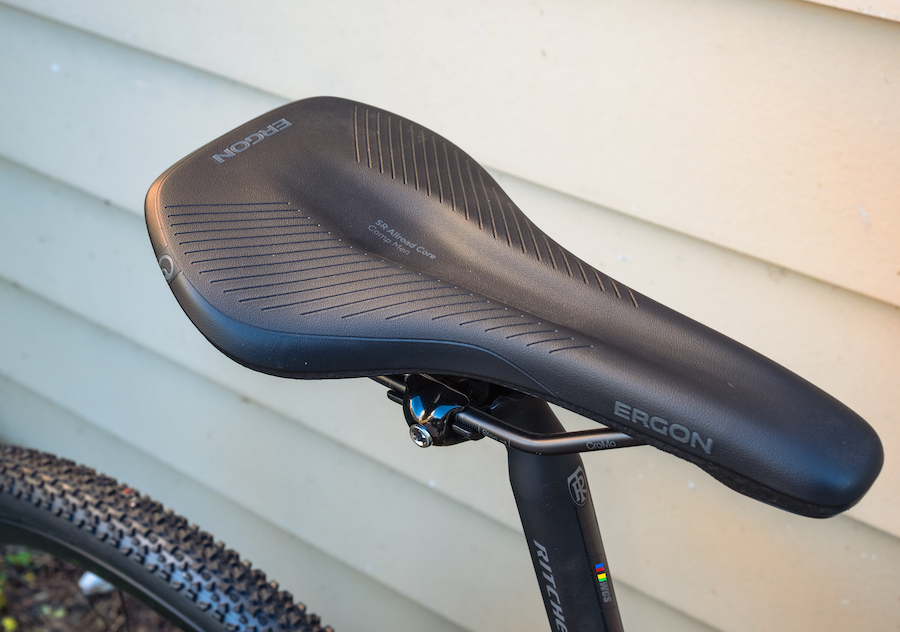
I had only ridden Fizik before this build, but Ergon’s latest design is a winner. The extra foam on this saddle is a welcomed feature on all terrains.
And that’s it. Of course, you can customize your flat-bar gravel bike however you want, depending on your preferences and budget. But the parts listed above resulted in an enjoyable yet performance-oriented bike.
The result is a bike that I love. It’s fast, fun, and comfortable. It handles well on any surface, giving me more confidence and visibility on the road. It’s also easier to maintain and adjust than a drop-bar bike. And it looks cool, too.
So, if you’re looking for a new way to enjoy various terrains or want to try something different, I recommend building a flat bar all-road bike. It’s not hard, it’s not expensive by today’s standards, and it’s worth it.
If you have any questions or comments, feel free to leave them below. And if you liked this post, please share it with your friends and fellow cyclists.

